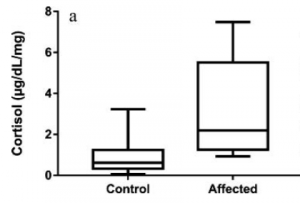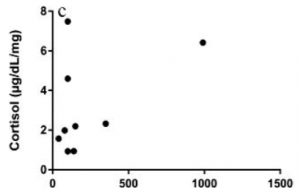Wind farms increase stress in nearby badgers
Effects of Noise on Wildlife, Science, Wind turbines Add commentsLay summary of
Rosanna CN Agnew, Valerie J Smith, Robert C Fowkes. Wind Turbines Cause Chronic Stress in Badgers (Meles meles) in Great Britain. Journal of Wildlife Diseases, 52(3), 2016. DOI: 10.7589/2015-09-231. Download PDF
A new study out of Britain provides one of the clearest looks at whether wind farms create chronic stress in wildlife populations. The results are striking—badgers living near turbines had stress levels 265% higher than the control groups—though not yet conclusive.
The researchers used what appears to be a very solid study design, testing cortisol levels in badger hair among 25 badger “setts” (dens, occupied by one or more badger families) separated into two groups: 9 “affected” setts were within 1km of wind farms, and 16 control setts were more than 10km from any wind farm. They made an effort to assure that control setts were comparable in their habitat types, distance from roads, and geographic spread across Britain.
 The overall results are fairly clear-cut. Here’s a graph of the two groups; the boxes show the 3 quartiles of results in each group (the bottom of the box being the level that 75% of the animals were above; the line across the box showing the level where half the animals were above, half below; and the top of the box the level that 25% of the animals were above), with the bars outside the box showing the remaining scatter of individuals. The mean among controls was .87, and among the affected group the mean was 3.16
The overall results are fairly clear-cut. Here’s a graph of the two groups; the boxes show the 3 quartiles of results in each group (the bottom of the box being the level that 75% of the animals were above; the line across the box showing the level where half the animals were above, half below; and the top of the box the level that 25% of the animals were above), with the bars outside the box showing the remaining scatter of individuals. The mean among controls was .87, and among the affected group the mean was 3.16
 A closer look at the results suggests that, as usual in field studies, there is a lot more going on than the means and medians suggest. Here we see a plot of the 9 affected setts, with distance to nearest turbine on the bottom axis. Interestingly, there is a wide scatter of results, with some setts (2 of the 9) showing levels very similar to the controls, about half (4 of the 9) having somewhat elevated levels, and only 3 setts being highly elevated, above the highest of the control setts. Our first image shows this skew, with the upper quartile of the affected box stretching far above the middle line (and thus pulling up the mean to a significant degree).
A closer look at the results suggests that, as usual in field studies, there is a lot more going on than the means and medians suggest. Here we see a plot of the 9 affected setts, with distance to nearest turbine on the bottom axis. Interestingly, there is a wide scatter of results, with some setts (2 of the 9) showing levels very similar to the controls, about half (4 of the 9) having somewhat elevated levels, and only 3 setts being highly elevated, above the highest of the control setts. Our first image shows this skew, with the upper quartile of the affected box stretching far above the middle line (and thus pulling up the mean to a significant degree).
This skewing does not invalidate the results; such scatter is very typical of most impact studies. But it does remind us that there is rarely a simple, universal cause-and-effect. The authors address many factors that could have contributed to anomalous results, and consider most of them to be quite unlikely; as they summarize, “Although certain intrinsic factors, such as sex, age, and disease status, have been thought to influence cortisol levels, it is very unlikely that the 264% cortisol increase experienced by affected badgers is a result of these factors alone.” Still, these and the other possible confounding factors will deserve closer scrutiny in followup studies.
The authors presume that vibration and noise, and likely infrasound, are the primary stressors, but did not do sound measurements as part of the study. There was no mention of whether badgers are stressed by tall structures, as some small mammals are (due to predation by hawks). While it seems likely that badgers are too large to be at risk from above, some confirmation of this would have been helpful to add, if true.
The researchers suggest that their results could have implications for controversies about humans who have reported negative reactions to wind farms, noting that badger hearing range is similar to humans. A final finding was that the badgers did not appear to acclimate to the wind farms: setts near new wind farms had only slightly higher stress levels than those near long-established ones, where the mean remained well above that of the controls.
